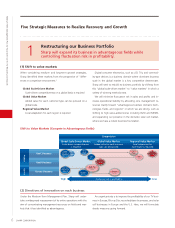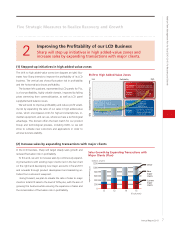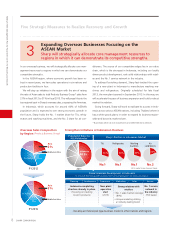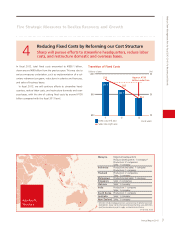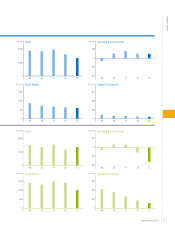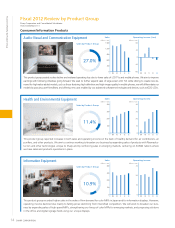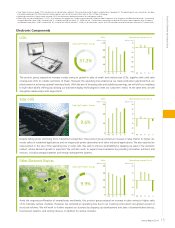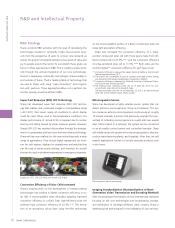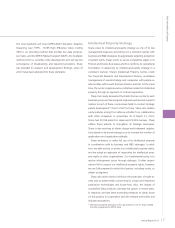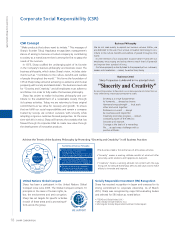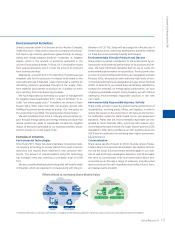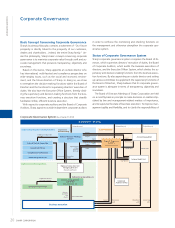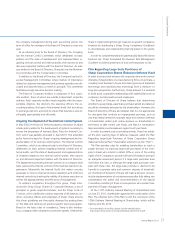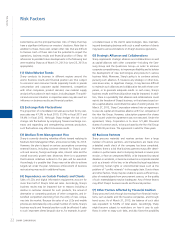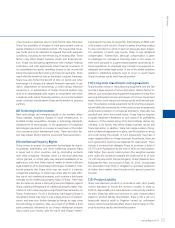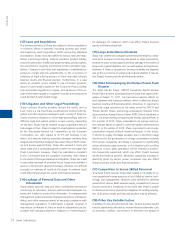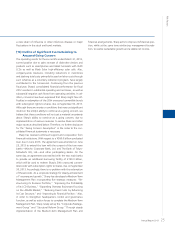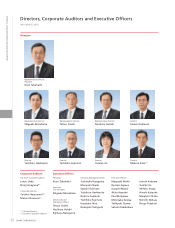Sharp 2013 Annual Report Download - page 18
Download and view the complete annual report
Please find page 18 of the 2013 Sharp annual report below. You can navigate through the pages in the report by either clicking on the pages listed below, or by using the keyword search tool below to find specific information within the annual report.
16 SHARP CORPORATION
R&D and Intellectual Property
R&D and Intellectual Property
R&D Strategy
Sharp conducts R&D activities with the goal of developing the
technologies needed to constantly create one-of-a-kind prod-
ucts from the perspective of users to uncover new demand, as
well as the goal of consistently delivering new levels of value and
joy to people around the world. To accomplish these goals, we
focus on three approaches to R&D. First is creating unique prod-
ucts through the vertical integration of our core technologies.
Second is leveraging commodity technologies shared widely in
and outside of Sharp. Third is tackling fields of technology that
are new to Sharp, with using “open innovation” and coopera-
tion with partners. These approaches allow us to perform dis-
tinctive, speedy, as well as efficient R&D.
Super Fast Response (SFR) LCD Technology
Sharp has developed super fast response (SFR) LCD technol-
ogy that realizes clear unstressed images in a temperature range
(–30˚C-90˚C) that covers nearly all conditions in which display
could be used. When used in low-temperature conditions, the
display performance of normal LCDs is impaired due to motion
blurring and tailing caused by lower response speeds. However,
Sharp’s SFR LCD has resolved this problem through the develop-
ment of a proprietary pixel structure and new driving technology.
Sharp will tap new markets for this new technology with a wide
range of applications. They include digital signage and car moni-
tors for cold regions, displays for smartphones and watches that
can be used in winter sports settings, and monitors for aircraft
that can be used in ultralow temperatures in emergency situations.
Conversion Efficiency of Solar Cells Increased
Sharp’s ongoing work on the development of energy-creating
technologies has resulted in higher conversion efficiency in so-
lar cells. A monocrystalline solar cell project targeting improved
conversion efficiency in a Black Solar high-efficiency solar cell
achieved high conversion efficiency of 22.3%.*1*2 The forma-
tion of an amorphous silicon layer using thin-film technology
Display at –30˚C SFR LCD (left) and normal LCD (right)
Imaging Standardization (Standardization of Next-
Generation Video Transmission and Encoding Method)
on the monocrystalline surface of a Back Contact type solar cell
raises light absorption efficiency.
Sharp also increased the conversion efficiency of a triple-
junction compound solar cell with three layers made from dif-
ferent compounds to 37.9%,*2*3 and the conversion efficiency
of a dye-sensitized solar cell to 11.9%.*2*3 Both ratios are the
world’s highest*4 conversion efficiency for each type of cell.
*1 Conversion efficiency measured by Japan Electrical Safety & Environment
Technology Laboratories (JET)
*2 The project was undertaken as part of a project promoted by New Energy
and Industrial Technology Development Organization (NEDO).
*3 Conversion efficiency measured by National Institute of Advanced Indus-
trial Science and Technology (AIST)
*4 The triple-junction compound solar cell: As of April 24, 2013, for non-
concentrator solar cells at the research stage.
The dye-sensitized solar cell: As of December 22, 2012, for dye-sensitized
solar cells at the research stage. (Sharp survey)
Microorganism Sensor
Sharp has developed a highly sensitive sensor system that can
detect airborne microorganisms (fungi and bacteria). The sys-
tem measures airborne microorganisms continuously at roughly
15-minute intervals, a process that previously required the man-
ual task of cultivating microorganisms in a petri dish over several
days. When linked to a network, the system can be connected
to an air quality control system and controlled remotely. Sharp
will initially target the system at food processing plants, pharma-
ceutical manufacturing plants, and hospitals. After that, we will
expand applications further to include everyday products used
in the home.
With the progressive formulation of new international standards
focusing on the core technologies over broadcasting, storage,
and distribution of ultrahigh-definition video content, Sharp is
developing key technologies for the realization of such services.
Microorganism sensor (prototype)


